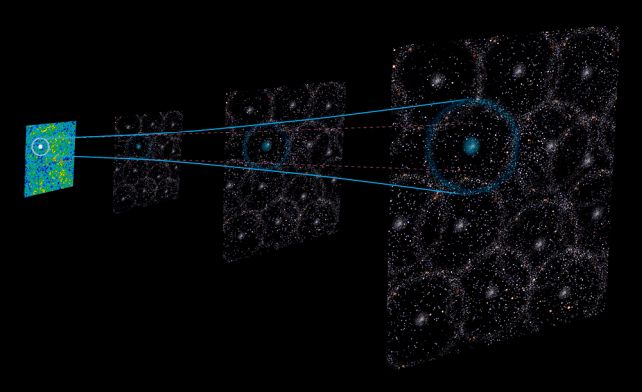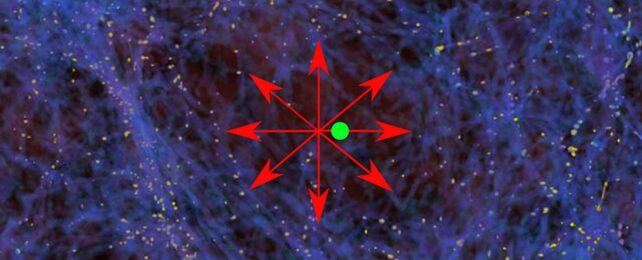Sound waves 'fossilized' in the arrangements of galaxies across the Universe support the theory that the Milky Way galaxy floats adrift in a giant void in space.
If this is the case, we could be teetering at the brink of solving one of the biggest problems in cosmology: the Hubble tension, a heretofore irresolvable discrepancy between measurements of the rate at which the Universe is expanding.
The Hubble tension exists because different ways of measuring how fast the Universe is expanding – a rate known as the Hubble constant – give us different results.
Measurements based on features of the early Universe, including the cosmic microwave background and baryon acoustic oscillations, tell us that the Hubble constant is around 67 kilometers per second per megaparsec.
Measurements based on things closer, like Type Ia supernovae and Cepheid variable stars, give us a Hubble constant of around 73 kilometers per second per megaparsec.
Related: This Is The Most Exciting Crisis in Cosmology

"A potential solution to this inconsistency is that our galaxy is close to the center of a large, local void," says cosmologist Indranil Banik of the University of Portsmouth in the UK.
"It would cause matter to be pulled by gravity toward the higher-density exterior of the void, leading to the void becoming emptier with time. As the void is emptying out, the velocity of objects away from us would be larger than if the void were not there. This therefore gives the appearance of a faster local expansion rate."
A void in intergalactic space is pretty much what it sounds like. Matter isn't completely evenly distributed in the Universe; it tends to clump together, creating regions of higher and lower density.

Astrophysicists have put forward the idea that the Milky Way is in just such a void as an explanation for the Hubble tension, with measurements of local space suggesting that our galaxy exists in a bubble about 2 billion light-years across that is 20 percent less dense than the average volume of space. However, this explanation is far from proven.
To investigate the possibility of a local void, Banik and his colleagues turned to baryon acoustic oscillations, or BAO.
When the Universe was just a wee baby, full of nothing but sloshing plasma, gravity and radiation combined to form waves of pressure that could shake their way through the compressed material.
When space grew too diffuse for vibrations to propogate, the pressure waves remained preserved as vast spherical arrangements of cosmic structures, with higher densities of matter at their edges.
This is the 'sound of the Big Bang', a buzz trapped in time across the Universe that is visible to us as ring shapes we call BAO. Because these rings froze at the same size – about 1 billion light-years in diameter – we can determine pretty much exactly how far away they should be.

According to the researchers' calculations, the presence of a local void should distort BAO in a way that ought to be measurable, especially since that distortion would increase at greater distances. They carefully reexamined 20 years' worth of BAO observations, and found a deviation from what we would expect from the standard model of cosmology, consistent with the distortion invoked by a local void.
Related: This Ginormous Bubble of Nearby Galaxies Could Be a Relic of The Big Bang
"A local void slightly distorts the relation between the BAO angular scale and the redshift, because the velocities induced by a local void and its gravitational effect slightly increase the redshift on top of that due to cosmic expansion," Banik explains.
"By considering all available BAO measurements over the last 20 years, we showed that a void model is about one hundred million times more likely than a void-free model with parameters designed to fit the CMB observations taken by the Planck satellite, the so-called homogeneous Planck cosmology."
The researchers say their void model results in a reduction in the Hubble tension from 3.3 sigma to 1.1 to 1.4 sigma. It's going to require some rigorous testing, but it suggests that at least part of the solution to this burning problem may at least partially be found in nothingness.
The team plans to embark on this testing regime, looking at objects in local space to see if these observations hold up to the notion of a local void.
The research has been published in the Monthly Notices of the Royal Astronomical Society, and presented at the Royal Astronomical Society National Astronomy Meeting 2025.
